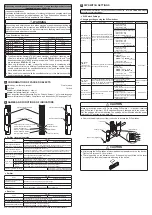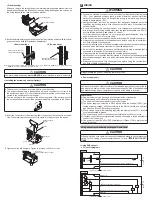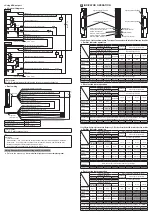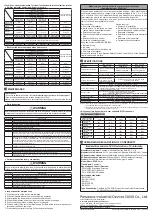
When using as a safety device for a press machine or paper shearing machine in Japan
(Applicable model: SF4D-□-01)
<Japanese regulations>
Standards for safety device mechanisms for press machines and shearing machines.
This device has passed, as indicated below, the "Type Examination" based on Arti-
cle 44, 2 of the Industrial Safety and Health Law of Japan.
WARNING
When using as a safety device for a press machine or paper shearing machine in
Japan, always attach the protective tube
SFPD-A10
(option) to the cable. The
safety device cannot be used for a press machine or shearing machine unless a
protective tube is attached to the cable.
<Type Examination Numbers>
Model No.
Type Examination Number
Safety light curtain
Specified control unit
Press machine
Shearing machine
SF4D-F
□
-01
,
SF4D-H
□
-01
-
TA601
TA603
SF4D-A
□
-01
-
TA600
TA602
SF4D-F
□
-01
,
SF4D-H
□
-01
SF-C11
TA605
-
SF4D-A
□
-01
SF-C11
TA604
-
SF4D-F
□
-01
,
SF4D-H
□
-01
SF-C13
TA607
-
SF4D-A
□
-01
SF-C13
TA606
-
●
Type Examination Numbers TA601 (press machine) and TA603 (shearing ma-
chine) are indicated on
SF4D-F□-01
units and
SF4D-H□-01
units, and Type
Examination Numbers TA600 (press machine) and TA602 (shearing machine)
are indicated on
SF4D-A□-01
units.
●
When only this device is used, or when this device is used in combination with
the specified control unit, a different Type Examination Number applies. When
used in combination with the specified control unit, the Type Examination Num
-
ber is indicated on the control unit.
● When used in combination with the specified control unit, this device cannot be
used for a shearing machine.
3
CONFIRMATION OF PACKED OBJECTS
Main body: emitter and receiver
One for each
Test Rod
1 piece
SF4D-F
□(
-01
):
SF4B-TR14
(ø14 × 220mm)
SF4D-H
□(
-01
):
SF4B-TR25
(ø25 × 220mm)
Quick Instruction Manual (Japanese, English, Chinese, Korean) 1 pc. for each language
General Information for Safety, Compliance, and Instructions (23 languages) 1 pc.
4
NAMES AND FUNCTIONS OF INDICATORS
Lower application indicator
Upper application indicator
Upper application indicator
Emitter: Light emission intensity control indicator
Receiver: Function setting indicator
Stable light
reception indicator
Emitter: Test indicator
Receiver: Interlock indicator
Digital indicator
Emitter: Operation indicator
Receiver: OSSD indicator
Frequency indicator
Lower application indicator
●
Emitter / receiver common
Name
Function
Line synchronization
Optical synchronization
Upper application indicator
(Blue / Red / Green / Orange)
<When beam axis alignment mode is set>
Control output (OSSD 1 / 2) ON: Lights blue, When top end beam channel receives
light: Lights red, When top end beam channel is blocked: Turns OFF
Lower application indicator
(Blue / Red / Green / Orange)
<When beam axis alignment mode is set>
Control output (OSSD 1 / 2) ON: Lights blue, When bottom end beam channel re
-
ceives light: Lights red, When bottom end beam channel is blocked: Turns OFF
Stable light reception indicator
(Green / Orange)
When light reception is stable: Lights green
When light reception is unstable: Lights orange
When light is blocked: Turns OFF
Digital indicator
(Green / Yellow)
Received light
intensity (Green)
Light intensity / Level 3: Lights green “3”, Light intensity / Level 2: Lights green “2”
Light intensity / Level 1: Lights green “1”, When light is blocked: Turns OFF
Error (Yellow)
Normal operation: Turns OFF, Error: Number blinks or lights yellow "0"
Polarity
(Yellow)
When PNP output is set: Lights yellow “P” (only during startup)
When NPN output is set: Lights yellow “n” (only during startup)
Frequency indicator (Orange)
-
When frequency 1 is set: One indicator lights orange
When frequency 2 is set: Two indicators light orange
●
Emitter
Name
Function
Line synchronization
Optical synchronization
Light emission intensity control
indicator (Orange)
Short mode: Turns OFF, Long mode: Lights orange
Test indicator (Orange)
During test: Lights orange, Normal operation: Turns OFF
Operation indicator
(Red / Green)
Control output (OSSD 1 / 2) OFF: Lights red
Control output (OSSD 1 / 2) ON: Lights green
Normal operation: Lights green
Error: Lights red
●
Receiver
Name
Function
Line synchronization
Optical synchronization
Function setting indicator (Orange)
Communication module connected: Blinks orange
Blanking function or parallel connection used: Lights orange (Applicable model:
SF4D-□
) (Note)
Interlock indicator (Yellow)
Interlock activated: Lights yellow, All other times: Turns OFF
OSSD indicator (Red / Green)
Control output (OSSD 1 / 2) OFF: Lights red
Control output (OSSD 1 / 2) ON: Lights green
Note: For details on the blanking function and parallel connection, refer to
“SF4D Series Instruction Manual”
.
5
DIP SWITCH SETTINGS
For detailed information on the functions of the device, refer “
our web site:
https://
panasonic.net/id/pidsx/global
”.
●
DIP Switch Settings
<Changing settings using the DIP switches>
Item
Description
Settings and ranges, indicator
Factory default setting
DIP switch 1 / 2
(Emitter / Receiver)
Synchronization
method
Selects the synchronization method.
When optical synchronization is se-
lected, you can set a different fre-
quency to reduce mutual interfer-
ence.
Line synchronization
•
DIP switch 1: OFF
•
DIP switch 2: OFF
Frequency indicator (orange): Turns OFF
Line synchronization
Optical synchronization, Frequency 1
•
DIP switch 1: ON
•
DIP switch 2: OFF
Frequency indicator (orange):
One indicator lights
Optical synchronization, Frequency 2
•
DIP switch 1: OFF
•
DIP switch 2: ON
Frequency indicator (orange):
Two indicators light
Line synchronization
•
DIP switch 1: ON
•
DIP switch 2: ON
Frequency indicator (orange): Turns OFF
DIP switch 3
(Emitter)
Light emission
intensity control
function
Controls the light from the emitter for
the change of sensing range.
Short mode
Sensing range
SF4D-F□
(
-01
): 0.2 to 7m
SF4D-H□
(
-01
),
SF4D-A□
(
-01
):
0.2 to 9m
•
DIP switch 3: OFF
Light emission intensity control
indicator (orange): Turns OFF
Short mode
Long mode
Sensing range
SF4D-F□
(
-01
): 0.8 to 12m
SF4D-H□
(
-01
),
SF4D-A□
(
-01
):
0.8 to 15m
•
DIP switch 3: ON
Light emission intensity control
indicator (orange): Lights
DIP switch 3
(Receiver)
Indicator selector
The upper application indicator and
lower application indicator can be
used as an beam axis alignment
mode or an application mode.
Beam axis alignment mode
•
DIP switch 3: OFF
Beam axis alignment
mode
Application mode
•
DIP switch 3: ON
DIP switch 4
(Emitter / Receiver)
Power save mode
Turns OFF the indicators reduce
power consumption.
Normal mode
(Allows illumination of some indicators)
•
DIP switch 4: OFF
Normal mode
Power save mode
(Upper application indicator and
lower application indicator, digital
indicator / received light intensity
are always turns OFF)
•
DIP switch 4: ON
CAUTION
Make sure that the power is OFF when setting DIP switch 1 / 2 (emitter / receiver)
and DIP switch 3 (emitter). If DIP switch settings are changed while the power is
ON, the settings will not be reflected. The settings will be reflected after the power
is turned OFF and then turned back ON.
●
Remove the indicator cover from the device to access the DIP switches.
This device
OFF
4
2
3
1
ON
<DIP switches>
Indicator cover
M2.6 screw (length 7mm)
CAUTION
●
After setting the DIP switches, always reattach the indicator cover on the device.
Tighten to a torque of 0.3N·m or less.
● There is packing on the indicator cover. If the packing is not fitted on the cover
properly, fit as shown below before attaching to the device.

























